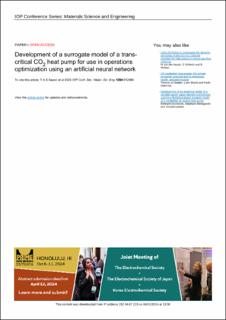| dc.contributor.author | Sazon, Thor Alexis Salazar | |
| dc.contributor.author | Zhang, Qian | |
| dc.contributor.author | Nikpey Somehsaraei, Homam | |
| dc.date.accessioned | 2024-04-17T11:14:11Z | |
| dc.date.available | 2024-04-17T11:14:11Z | |
| dc.date.created | 2024-01-03T09:08:03Z | |
| dc.date.issued | 2023 | |
| dc.identifier.citation | Sazon, T. A. S., Zhang, Q., & Nikpey, H. (2023, December). Development of a surrogate model of a trans-critical CO2 heat pump for use in operations optimization using an artificial neural network. In IOP Conference Series: Materials Science and Engineering (Vol. 1294, No. 1, p. 012060). IOP Publishing. | en_US |
| dc.identifier.issn | 1757-8981 | |
| dc.identifier.uri | https://hdl.handle.net/11250/3127006 | |
| dc.description.abstract | Conventional physics-based models can demand substantial computational resources when employed for operational optimization. To allow faster system simulations that can be employed for operational optimization, a surrogate model of the CO2 heat pump has been developed using an artificial neural network (ANN). The ANN model takes in six (6) inputs: evaporator water-side mass flow, its temperature, gas cooler water-side mass flow, its temperature, set-point output temperature, and high-side heat pump pressure. The model's outputs comprise the electrical energy needed to run the heat pump, the heat from the gas coolers, the temperature of the heat pump-heated fluid, and the outlet temperature of the heat pump's evaporator. Data used for training, validating, and testing the ANN model were generated by running a calibrated Modelica model of the CO2 heat pump for various combinations of input parameters obtained from Latin hypercube sampling. The ANN model developed includes an input layer with 6 inputs, 2 hidden dense layers, each with 30 neurons, and an output layer for 4 outputs (6-30-30-3). The ReLU activation function was implemented on each hidden layer and no regularizations were imposed. The Adam optimizer was used with a learning rate of 0.001 specified. Early stopping (patience = 2000) was implemented to ensure that the training data was not overfitted. A maximum of 30000 epochs was specified. The resulting Mean Square Error (MSE) obtained for the training, validation, and testing data sets were 1.38x10−5, 2.05x10−5, and 3.65x10−5, respectively. When tested against one-week operational runs generated by Modelica, the Root Mean Square Errors (RMSEs) for coefficient of performance (COP)s for spring, summer, autumn, and winter operations obtained were 0.232, 0.346, 0.089 and 0.076, respectively. The resulting surrogate ANN model can be integrated into the system model as a functional mock-up unit within Modelica to facilitate faster simulations for operational optimization. | en_US |
| dc.language.iso | eng | en_US |
| dc.publisher | IOP Publishing | en_US |
| dc.rights | Navngivelse 4.0 Internasjonal | * |
| dc.rights.uri | http://creativecommons.org/licenses/by/4.0/deed.no | * |
| dc.title | Development of a surrogate model of a trans-critical CO2 heat pump for use in operations optimization using an artificial neural network | en_US |
| dc.type | Peer reviewed | en_US |
| dc.type | Journal article | en_US |
| dc.description.version | publishedVersion | en_US |
| dc.rights.holder | The authors | en_US |
| dc.subject.nsi | VDP::Teknologi: 500 | en_US |
| dc.source.volume | 1294 | en_US |
| dc.source.journal | IOP Conference Series: Materials Science and Engineering | en_US |
| dc.identifier.doi | 10.1088/1757-899X/1294/1/012060 | |
| dc.identifier.cristin | 2219534 | |
| cristin.ispublished | true | |
| cristin.fulltext | original | |
| cristin.qualitycode | 1 | |

